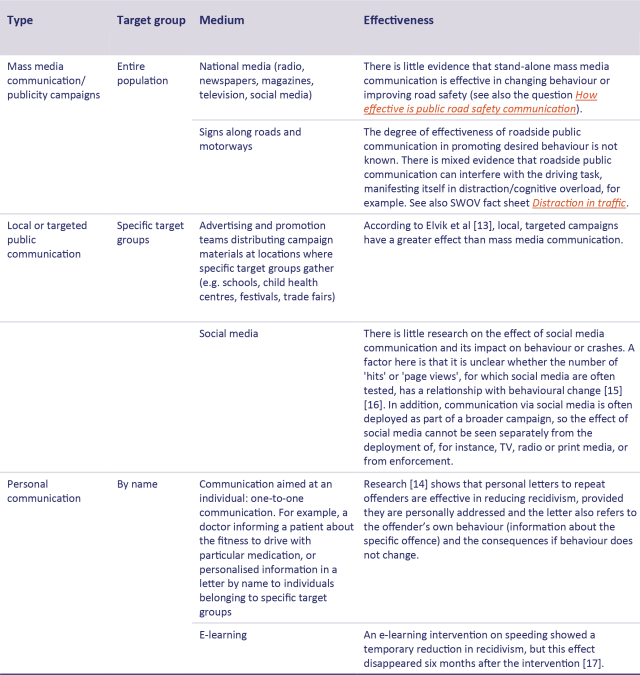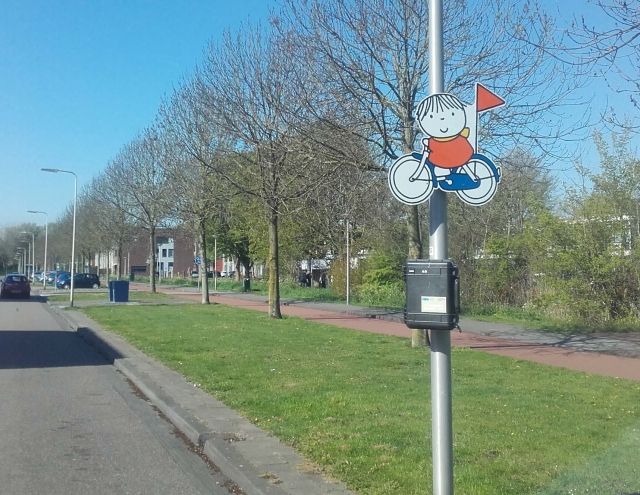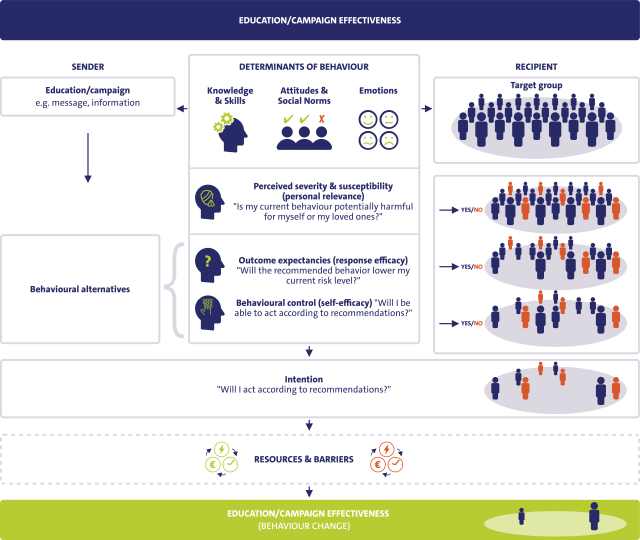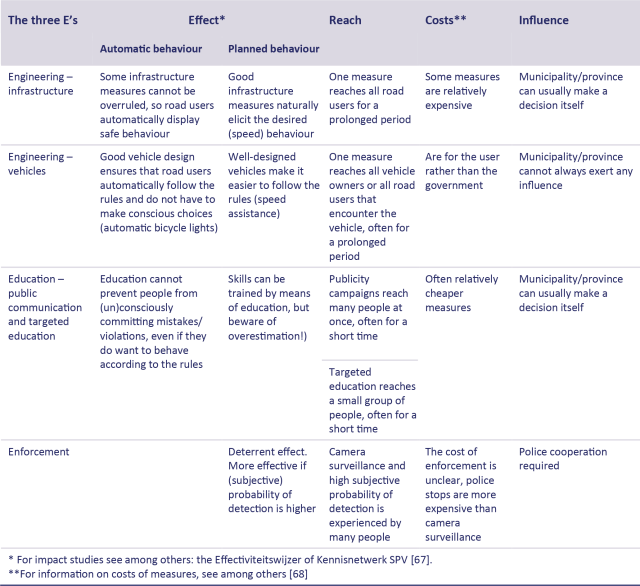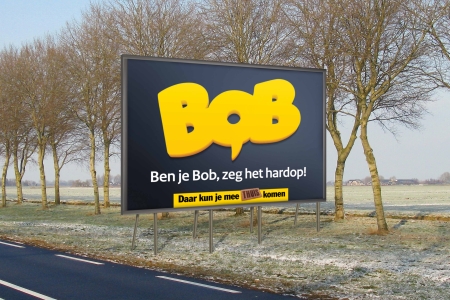Below you will find the list of references that are used in this fact sheet; all sources can be consulted or retrieved. Via Publicaties you can find more literature on the subject of road safety.
[1]. Rijksoverheid (2019). 'Laat je telefoon lekker zitten en hou 95 euro in je zak'. Accessed on 12-07-2022 at www.rijksoverheid.nl/actueel/nieuws/2019/06/28/%E2%80%98laat-je-telefoon-lekker-zitten-en-hou-95-euro-in-je-zak%E2%80%99.
[2]. Delhomme, P., Dobbeleer, W. de, Forward, S. & Simões, A., (eds.) (2009). Campaigns and Awareness raising Strategies in Traffic safety (CAST). Manual for designing, implementing, and evaluating road safety communication campaigns. Belgisch Instituut voor de Verkeersveiligheid (BIVV), Brussel.
[3]. Phillips, R.O., Ulleberg, P. & Vaa, T. (2011). Meta-analysis of the effect of road safety campaigns on accidents. In: Accident Analysis & Prevention, vol. 43, nr. 3, p. 1204-1218.
[4]. Fisa, R., Musukuma, M., Sampa, M., Musonda, P., et al. (2022). Effects of interventions for preventing road traffic crashes: an overview of systematic reviews. In: BMC Public Health, vol. 22, nr. 1, p. 513.
[5]. Faus, M., Alonso, F., Fernández, C. & Useche, S.A. (2021). Are traffic announcements really effective? A systematic review of evaluations of crash-prevention communication campaigns. In: Safety, vol. 7, nr. 4, p. 66.
[6]. Webb, T.L. & Sheeran, P. (2006). Does changing behavioral intentions engender behavior change? A meta-analysis of the experimental evidence. In: Psychological Bulletin, vol. 132, nr. 2, p. 249-268.
[7]. Sheeran, P. & Webb, T.L. (2016). The Intention–Behavior Gap. In: Social and Personality Psychology Compass, vol. 10, nr. 9, p. 503-518.
[8]. Mantzari, E., Reynolds, J.P., Jebb, S.A., Hollands, G.J., et al. (2022). Public support for policies to improve population and planetary health: A population-based online experiment assessing impact of communicating evidence of multiple versus single benefits. In: Social Science & Medicine, vol. 296, p. 114726.
[9]. Bartels, G., Nelissen, W. & Ruelle, H. (1998). Draagvlak en de wisselwerking tussen zender en ontvanger. In: De transactionele overheid: Communicatie als instrument. Kluwer Bedrijfsinformatie, Deventer, p. 403-409.
[10]. Smulders, M. (2018). Wat betekent de Marktvisie voor u? Een onderzoek naar draagvlak voor de Marktvisie en de wijze waarop deze visie zich manifesteert binnen het programma Sluizen van Rijkswaterstaat. Master scriptie Erasmus Universiteit Rotterdam EUR, Erasmus School of Social and Behavioural Sciences
[11]. Eriksson, L., Garvill, J. & Nordlund, A.M. (2006). Acceptability of travel demand management measures. The importance of problem awareness, personal norm, freedom, and fairness. In: Journal of Environmental Psychology, vol. 26, nr. 1, p. 15-26.
[12]. Klösters, M. (2022). Draagvlak voor klimaatbeleid in een notendop: wat weten we al? TNO.
[13]. Elvik, R., Høye, A., Vaa, T. & Sørensen, M. (2009). The handbook of road safety measures. Second edition. Emerald, UK.
[14]. Goldenbeld, C. & Mesken, J. (2012). Verkeersovertreders, achtergronden van gedrag en mogelijkheden voor beïnvloeding door voorlichting. Een literatuurstudie [Traffic offenders, backgrounds to behaviour and options for intervention through education; A literature study]e. R-2012-15 [Summary in English]. SWOV, Leidschendam.
[15]. Paek, H.J., Kim, K. & Hove, T. (2010). Content analysis of antismoking videos on YouTube: message sensation value, message appeals, and their relationships with viewer responses. In: Health Education Research, vol. 25, nr. 6, p. 1085-1099.
[16]. Murray, C. & Lewis, I. (2011). Is there an app for that? Social media uses for road safety. Proceedings of the ACRS National Conference 2011, Australasian College of Road Safety 1-15.
[17]. af Wåhlberg, A.E. (2011). Re-education of young driving offenders: Effects on recorded offences and self-reported collisions. In: Transportation Research Part F: Traffic Psychology and Behaviour, vol. 14, nr. 4, p. 291-299.
[18]. Davis, R., Campbell, R., Hildon, Z., Hobbs, L., et al. (2015). Theories of behaviour and behaviour change across the social and behavioural sciences: a scoping review. In: Health Psycholy Review, vol. 9, nr. 3, p. 323-344.
[19]. Schwarzer, R. & Luszczynska, A. (2008). How to overcome health-compromising behaviors: The health action process approach. In: European Psychologist, vol. 13, p. 141-151.
[20]. Rosenstock, I.M. (1997). Historical origins of the health belief model. In: Health education monographs. Volume 2(4), p. 328-335.
[21]. Carpenter, C.J. (2010). A meta-analysis of the effectiveness of health belief model variables in predicting behavior. In: Health Communication, vol. 25, nr. 8, p. 661-669.
[22]. Fisher, W.A., Fisher, J.D. & Harman, J. (2003). The Information-Motivation-Behavioral Skills Model: a general social psychological approach to understanding and promoting health behavior. In: Suls, J. & Wallston, K.A. (red.), Social Psychological Foundations of Health and Illness. p. 82-106.
[23]. Deci, E.L. & Ryan, R.M. (2000). The "what" and "why" of goal pursuits: human needs and the self-determination of behavior. In: Psychological Inquiry, vol. 11, nr. 4, p. 227-268.
[24]. Nabavi, R.T. (2012). Bandura’s social learning theory & social cognitive learning theory. In: Theories of Developmental Psychology. p. 1-24.
[25]. Ajzen, I. (1991). The theory of planned behavior. In: Organizational Behavior and Human Decision Processes, vol. 50, nr. 2, p. 179-211.
[26]. La Barbera, F. & Ajzen, I. (2020). Control interactions in the Theory of Planned Behavior: Rethinking the role of subjective norm. In: Europe's Journal of Psychology, vol. 16, nr. 3, p. 401-417.
[27]. Guttman, N. (2016). Reprint of “Persuasive appeals in road safety communication campaigns: Theoretical frameworks and practical implications from the analysis of a decade of road safety campaign materials”. In: Accident Analysis & Prevention, vol. 97, p. 298-308.
[28]. Goldenbeld, C. (1996). Evaluatie van de campagne `Voorkom nekletsel' [Evaluation of the campaign ‘Prevent neck injury']. R-96-43 [Summary in English]. SWOV, Leidschendam.
[29]. Musselwhite, C., Avineri, E., Susilo, Y., Fulche, E., et al. (2010). Understanding public attitudes to road user safety. Road Safety Research Report No. 111. Centre for Transport & Society, University of the West of England, Bristol.
[30]. Wakefield, M.A., Loken, B. & Hornik, R.C. (2010). Use of mass media campaigns to change health behaviour. In: Lancet, vol. 376, nr. 1261-1271.
[31]. White, B.X. & Albarracín, D. (2018). Investigating belief falsehood. Fear appeals do change behaviour in experimental laboratory studies. A commentary on Kok et al. (2018). In: Health Psychology Review, vol. 12, nr. 2, p. 147-150.
[32]. Moussaoui, L.S., Claxton, N. & Desrichard, O. (2021). Fear appeals to promote better health behaviors: an investigation of potential mediators. In: Health Psychology and Behavioral Medicine, vol. 9, nr. 1, p. 600-618.
[33]. Koehler, M., Brockamp, T., Bamberg, S. & Gehlert, T. (2022). Change of risk behaviour in young people - the effectiveness of the trauma prevention programme P.A.R.T.Y. considering the effect of fear appeals and cognitive processes. In: BMC Public Health, vol. 22, nr. 1, p. 595.
[34]. Hoog, N. de, Stroebe, W. & Wit, J.B.F de. (2005). The impact of fear appeals on processing and acceptance of action recommendations. In: Personality and Social Psychology Bulletin, vol. 31, nr. 1, p. 24-33.
[35]. Algie, J. & Mead, N.L. (2019). Fun ways to engage with rail safety through the dumb ways to die social marketing campaign. In: Springer Texts in Business and Economics.
[36]. Carey, R.N., McDermott, D.T. & Sarma, K.M. (2013). The impact of threat appeals on fear arousal and driver behavior: A meta-analysis of experimental research 1990-2011. In: PLoS ONE, vol. 8, nr. 5, p. e62821.
[37]. Bigsby, E. & Albarracín, D. (2022). Self- and response efficacy information in fear appeals: A meta-analysis. In: Journal of Communication, vol. 72, nr. 2, p. 241–263.
[38]. Tannenbaum, M.B., Hepler, J., Zimmerman, R.S., Saul, L., et al. (2015). Appealing to fear: A meta-analysis of fear appeal effectiveness and theories. In: Psychological Bulletin, vol. 141, nr. 6, p. 1178-1204.
[39]. Ngondo, P.S. & Klyueva, A. (2019). Fear appeals in road safety advertising: an analysis of a controversial social marketing campaign in Russia. In: Russian Journal of Communication, vol. 11, nr. 2, p. 167-183.
[40]. Kok, G., Peters, G.-J.Y., Kessels, L.T.E., Hoor, G.A. ten, et al. (2018). Ignoring theory and misinterpreting evidence: the false belief in fear appeals. In: Health Psychology Review, vol. 12, nr. 2, p. 111-125.
[41]. Diegelmann, S., Ninaus, K. & Terlutter, R. (2020). Distracted driving prevention: an analysis of recent UK campaigns. In: Journal of Social Marketing.
[42]. Cutello, C.A., Hellier, E., Stander, J. & Hanoch, Y. (2020). Evaluating the effectiveness of a young driver-education intervention: Learn2Live. In: Transportation Research Part F: Traffic Psychology and Behaviour, vol. 69, p. 375-384.
[43]. Gauld, C.S., Lewis, I.M., White, K.M., Watson, B.C., et al. (2020). Gender differences in the effectiveness of public education messages aimed at smartphone use among young drivers. In: Traffic Injury Prevention, vol. 21, nr. 2, p. 127-132.
[44]. Tay, R. (2018). Effects of roadside memorials on red light running intention in different age, gender and personality groups. In: Transportation Research Part F: Traffic Psychology and Behaviour, vol. 54, p. 86-95.
[45]. Rijksoverheid (2021). Wie is Bob en waar staat Bob voor? Ministerie van Infrastructuur en Waterstaat. Accessed on 27-05-2021 at www.rijksoverheid.nl/onderwerpen/verkeersveiligheid/vraag-en-antwoord/wie-is-bob-en-waar-staat-bob-voor.
[46]. WHO (2009). Evidence for the effectiveness and cost-effectiveness of interventions to reduce alcohol-related harm. World Health Organization Regional Office for Europe, Copenhagen.
[47]. Fell, J.C., Scolese, J., Achoki, T., Burks, C., et al. (2020). The effectiveness of alternative transportation programs in reducing impaired driving: A literature review and synthesis. In: Journal of Safety Research, vol. 75, p. 128-139.
[48]. Cammaert, M. & Woudstra, M. (2021). Campagne-effectonderzoek BOB 2020. DVJ Insights, commissioned by the Ministry of Infrastructure and Water Management.
[49]. Tay, R. (2005). The effectiveness of enforcement and publicity campaigns on serious crashes involving young male drivers: Are drink driving and speeding similar? In: Accident Analysis & Prevention, vol. 37, nr. 5, p. 922-929.
[50]. Elvik, R. (2010). Why some road safety problems are more difficult to solve than others. In: Accident Analysis & Prevention, vol. 42, nr. 4, p. 1089-1096.
[51]. Schagen, I. van, Commandeur, J.J.F., Goldenbeld, C. & Stipdonk, H. (2016). Monitoring speed before and during a speed publicity campaign. In: Accident Analysis & Prevention, vol. 97, p. 326-334.
[52]. Gehlert, T., Schulze, C. & Schlag, B. (2012). Evaluation of different types of dynamic speed display signs. In: Transportation Research Part F: Traffic Psychology and Behaviour, vol. 15, nr. 6, p. 667-675.
[53]. Malin, F. & Luoma, J. (2020). Effects of speed display signs on driving speed at pedestrian crossings on collector streets. In: Transportation Research Part F: Traffic Psychology and Behaviour, vol. 74, p. 433-438.
[54]. Karimpour, A., Kluger, R., Liu, C. & Wu, Y.-J. (2021). Effects of speed feedback signs and law enforcement on driver speed. In: Transportation Research Part F: Traffic Psychology and Behaviour, vol. 77, p. 55-72.
[55]. Ando, R., Noda, K., Mimura, Y., Yamazaki, M., et al. (2017). Long-term effect analysis of dynamic speed display sign in streets. Proceedings of the 4th International Conference on Transportation Information and Safety (ICTIS), p. 522-529.
[56]. Hallmark, S., Hawkins, N. & Smadi, O. (2015). Evaluation of dynamic speed feedback signs on curves: a national demonstration Project. Federal Highway Administration, United States.
[57]. Vlakveld, W., Goldenbeld, C. & Groot, J. de (2022). Road signs depicting childrens's book illustrations temporarily reduce speed on urban roads. In: Transportation Research Part F: Psychology and Behaviour, vol. 87, p. 236-248.
[58]. Chebat, D.-R., Lemarié, L., Rotnemer, B., Talbi, T., et al. (2021). The young and the reckless: Social and physical warning messages reduce dangerous driving behavior in a simulator. In: Journal of Retailing and Consumer Services, vol. 63, p. 102701.
[59]. Mak, P. (2020). Apparatuurgebruik, gordeldracht en gebruik kinderzitjes door automobilisten en chauffeurs: in auto's, bestelwagens en vrachtwagens. Rijkswaterstaat, research performed by NDC Nederland, Goudappel Coffeng.
[60]. Aarts, L.T., Broek, L.J. van den, Oude Mulders, J., Decae, R.J., et al. (2022). Achtergronden bij De Staat van de Verkeersveiligheid 2022. De jaarlijkse monitor. R-2022-10A. SWOV, Den Haag.
[61]. Cammaert, M. & Vinke, S. (2022). Campagneeffectonderzoek MONO: Automobilisten en fietsers. DVJ Insights, commissioned by the Ministry of Infrastructure and Water Management, Utrecht.
[62]. Kremers, S. & Munnik, Z. (2022). Campagne-effectonderzoek MONO automobilisten en fietsers. DVJ Insights, commissioned by the Ministry of Infrastructure and Water Management, Utrecht.
[63]. Goldenbeld, C., Boele, M.J. & Commandeur, J.J.F. (2016). Evaluatie fietshelmcampagne 'Coole kop, helm op!' in Zeeland. Effecten op helmgebruik en factoren van invloed [Evaluation bicycle helmet campaign 'Wanna look cool, wear a helmet!' in the Province of Zeeland in the Netherlands; Effects on helmet use and influential factors]. R-2016-8 [Summary in English]. SWOV, Den Haag.
[64]. DVS (2009). Thuiskomen in 2008; Een overzicht van de monitoringsresultaten van de verkeersveiligheidscampagnes in 2003-2008. Dienst Verkeer en Scheepvaart, Rijkswaterstaat, Delft.
[65]. SWOV & CROW (2021). Handreiking gedragsverandering in het verkeer. KN SPV 2021-4. Kennisnetwerk SPV, Utrecht.
[66]. Treat, J.R. (1977). Tri-level study of the causes of traffic accidents an overview of final results. Proceedings of the 21st Conference of the Association for the Advancement of Automotive Medicine AAAM. Vancouver, British Columbia, Canada, September 15-17, 1977. p. 391-403
[67]. Kennisnetwerk SPV (2023). Effectiviteitswijzer. Kennisnetwerk Strategisch Plan Verkeersveiligheid. Accessed on 15-02-2023 at www.kennisnetwerkspv.nl/Aan-de-slag/Effectiviteitswijzer.
[68]. SWOV & CROW (2019). Investeren in verkeersveiligheid. Vijf maatregelen om het fundament op orde te krijgen. Kennisnetwerk SPV, Utrecht.

